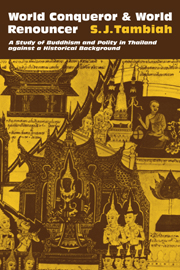 World Conqueror and World Renouncer
World Conqueror and World Renouncer Book contents
- Frontmatter
- Contents
- Acknowledgments
- PART ONE
- 1 Introduction: Reconstructing a Journey
- 2 From Rajadharma (the King's “Whole Duty”) to Dharmaraja (the “Righteous Ruler”)
- 3 The Brahmanical Theory of Society and Kingship
- 4 The Early Buddhist Conception of World Process, Dharma, and Kingship
- 5 Asoka Maurya: The Paradigm
- 6 Thai Kingship and Polity in Historical Perspective
- 7 The Galactic Polity
- 8 The Kingdom of Ayutthaya: Design and Process
- 9 Asokan and Sinhalese Traditions Concerning the Purification of the Sangha
- 10 The Sangha and the Polity: From Ayutthaya to Bangkok
- 11 The Nineteenth-Century Achievements of Religion and Sangha
- 12 The Sangha Acts of 1902, 1941, and 1963
- PART TWO
- Bibliography
- Index
5 - Asoka Maurya: The Paradigm
Published online by Cambridge University Press: 10 November 2010
- Frontmatter
- Contents
- Acknowledgments
- PART ONE
- 1 Introduction: Reconstructing a Journey
- 2 From Rajadharma (the King's “Whole Duty”) to Dharmaraja (the “Righteous Ruler”)
- 3 The Brahmanical Theory of Society and Kingship
- 4 The Early Buddhist Conception of World Process, Dharma, and Kingship
- 5 Asoka Maurya: The Paradigm
- 6 Thai Kingship and Polity in Historical Perspective
- 7 The Galactic Polity
- 8 The Kingdom of Ayutthaya: Design and Process
- 9 Asokan and Sinhalese Traditions Concerning the Purification of the Sangha
- 10 The Sangha and the Polity: From Ayutthaya to Bangkok
- 11 The Nineteenth-Century Achievements of Religion and Sangha
- 12 The Sangha Acts of 1902, 1941, and 1963
- PART TWO
- Bibliography
- Index
Summary
Scholars have found themselves at variance in their interpretations of the nature of the Buddhist content of Asokan political and religious policy. On the one hand there is the highly idealized and embellished partisan view stated in the Buddhist chronicles and legends that Asoka was the great dhammika dhammaraja, the builder of grand architectural monuments all over India, the great patron of Buddhism, its defender as, for instance, described in the story of the Third Council and the expulsion of 80,000 heretics under the direction of the great monk-elder, Mogaliputta Tissa, and its propagator, as eulogized in the legend of the nine missions sent to spread the message of Buddhism, six within his vast kingdom and three to Ceylon, the “Yona” country (perhaps Bactria) and Suvarna-bhumi (in popular tradition located in the Burma-Siam region).
Certain scholars (e.g., Dutt 1962 and Thapar 1961) have insisted that the Buddhist protagonist “mythologization” of Asoka as the Buddhist emperor, based on the legends and accounts fathered by the monks (as, for example, the Sinhalese chronicles), should be kept separate from the historian's assessment of the evidence based on the inscriptions and archaeological finds.
Unfortunately, the evidence on which to base an objective history of the Asokan era is none too plentiful. The position that we take is twofold:
1. Insofar as the Theravada literature, especially the chronicles and legends, have provided the model of kingship for the kings of Theravada polities, a model both generating and legitimating political action, such a model becomes a part of history and must be seriously taken into account.
- Type
- Chapter
- Information
- World Conqueror and World RenouncerA Study of Buddhism and Polity in Thailand against a Historical Background, pp. 54 - 72Publisher: Cambridge University PressPrint publication year: 1976


